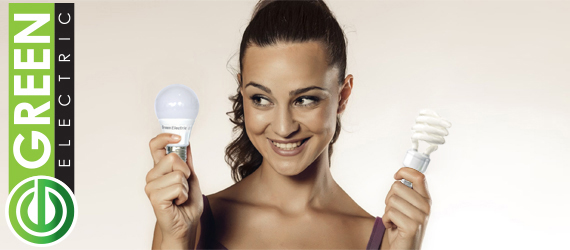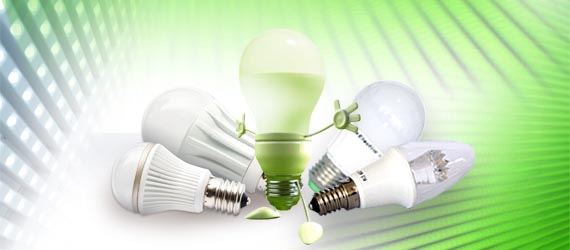| # | LED | CFL |
| 1 | Produce more Light with lesser amount of electrical power. More efficient | Need more power than LED to produce same amount of light. Less efficient |
| 2 | Green Electric LED light does not contain Mercury, hence no disposal problem. | CFL content mercury, hence hazardous and disposal problem. (5 CFLs life = 1 LED lamp life) |
| 3 | No UV Light | Produce ultraviolet light, leakage affects human body cells. |
| 4 | No UV Light | Leakage ultraviolent components affect chemical paints eg. House paint, paintings, clothes etc. |
| 5 | Object oriented illumination (Unidirectional light) | Wastage of Light (360deg illumination) |
| 6 | Less heat, energy saving. | Produce more heat than LED. Air Condition consumes more power in CFL environment. |
| 7 | Functions in -20 deg to 50 deg. | In cold temperature, efficiency reduces or some time does not function. |
| 8 | Generally uses acrylic / PVC / PM covers. | Uses glass tube. Chances of breakage during handling & transport. |
| 9 | Life cycle independent of number of switching (ON/OFF). | Life cycle depends upon number of switching (ON/OFF). |
| 10 | Maintenance friendly. | Frequent maintenance damages the interior. |
Knowledge Center
Green Electric LED vs CFL

What is Green Electric LED?

Light emitting diodes, more commonly referred to as LEDs, are a type of solid-state lighting that utilizes a semiconductor for converting electricity into actual light. The modern LED bulbs may be six or seven times more efficient than the traditional incandescent lights and help to cut a home’s or business’s energy costs by as much as 80 percent.
What You Never Knew about Green Electric LED Lights
There is no question that more and more homeowners and business owners are switching their lighting to energy efficient LEDs.
Life of the Green Electric LED Bulb
A quality LED bulb can have a useful life period of 25,000 hours, in some cases more. This means the LED bulb lasts up to 25 times longer than a traditional light bulb you install in your home or business.
More Efficient Use of Energy
Green Electric LED Lighting - Innovation for today and tomorrow. Our Green Electric LED energy – saving Green Electric LED light bulbs offer a high-quality, energy efficient alternative to incandescent , bulbs, going forward, Green Electric LED technology will open your world to be.
Unlike the traditional incandescent bulb, which are designed to release as much as 90 percent of their total energy as heat, a LED bulb uses energy in a far more efficient manner. As a result, These energy saving bulbs can save your Money, on your electric bill, And to get you stored on saving, Green Electric offers valuable things that on
Uses for Green Electric LED Lights
LED lights are found in a number of things you encounter each day, such as TVs, traffic lights and even brake lights on vehicles. Due to their unique characteristics, which include the small size, resistance to breakage, simple maintenance and the ability to focus the light in one direction, these lights are perfect for a number of different applications.
Do Green Electric LEDs provide high quality lighting?

Green Electric LED Lighting can have a powerful impact in our environment
Key aspects of lighting quality are color appearance and color rendering, both of which are explained below:
 Color appearance is communicated using correlated color temperature (CCT) on the Kelvin (K) scale. For most interior lighting applications, warm-white (2700K to 3000K) and in some cases neutral-white (3500K to 4000K) light is appropriate. Cool-white (6500k) LEDs with very high CCT (bluish in appearance) tend to offer higher efficacy at low cost, but may not meet user expectations for color. An increasing number of high-efficacy LED products are available in warm-white or neutral-white colors, to the point where many have surpassed CFLs. Two light sources with identical CCTs can render object colors very differently due to the differences in spectra. While CCT provides an indication of whether a light source may appear yellowish or bluish in color, Duv is an additional metric that can help identify sources with excessively greenish or pinkish hues.
Color appearance is communicated using correlated color temperature (CCT) on the Kelvin (K) scale. For most interior lighting applications, warm-white (2700K to 3000K) and in some cases neutral-white (3500K to 4000K) light is appropriate. Cool-white (6500k) LEDs with very high CCT (bluish in appearance) tend to offer higher efficacy at low cost, but may not meet user expectations for color. An increasing number of high-efficacy LED products are available in warm-white or neutral-white colors, to the point where many have surpassed CFLs. Two light sources with identical CCTs can render object colors very differently due to the differences in spectra. While CCT provides an indication of whether a light source may appear yellowish or bluish in color, Duv is an additional metric that can help identify sources with excessively greenish or pinkish hues.
 Color rendering, or color rendering index (CRI) measures the ability of light sources to render colors, compared to either incandescent reference sources if warm in color, or daylight reference sources if cooler in color. The leading high-efficiency LED manufacturers now claim a CRI of 80 or higher for phosphor-converted, warm-white devices. In general, a minimum CRI of 80 is recommended for interior lighting, with CRIs of 90 or higher indicating excellent color rendering.
Color rendering, or color rendering index (CRI) measures the ability of light sources to render colors, compared to either incandescent reference sources if warm in color, or daylight reference sources if cooler in color. The leading high-efficiency LED manufacturers now claim a CRI of 80 or higher for phosphor-converted, warm-white devices. In general, a minimum CRI of 80 is recommended for interior lighting, with CRIs of 90 or higher indicating excellent color rendering.